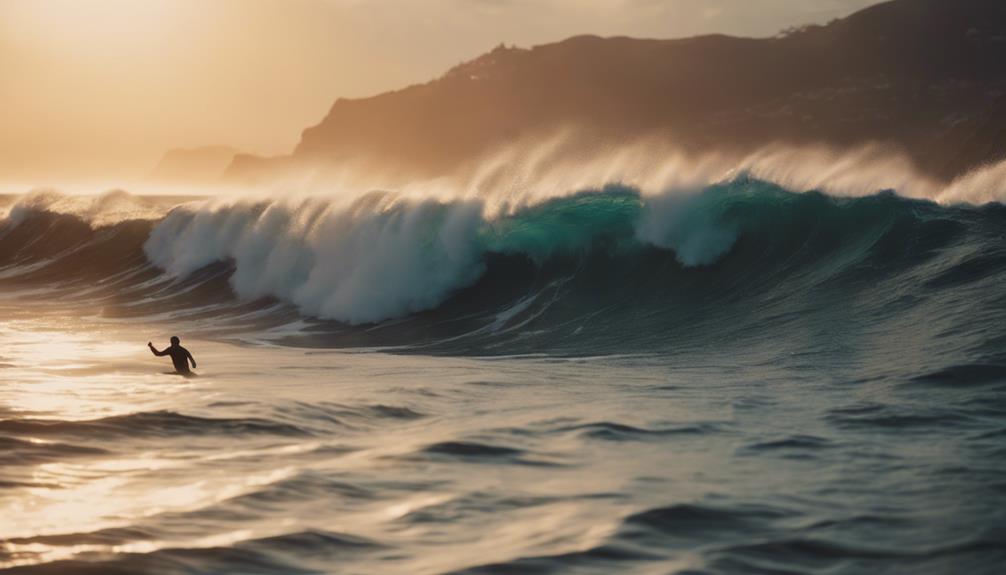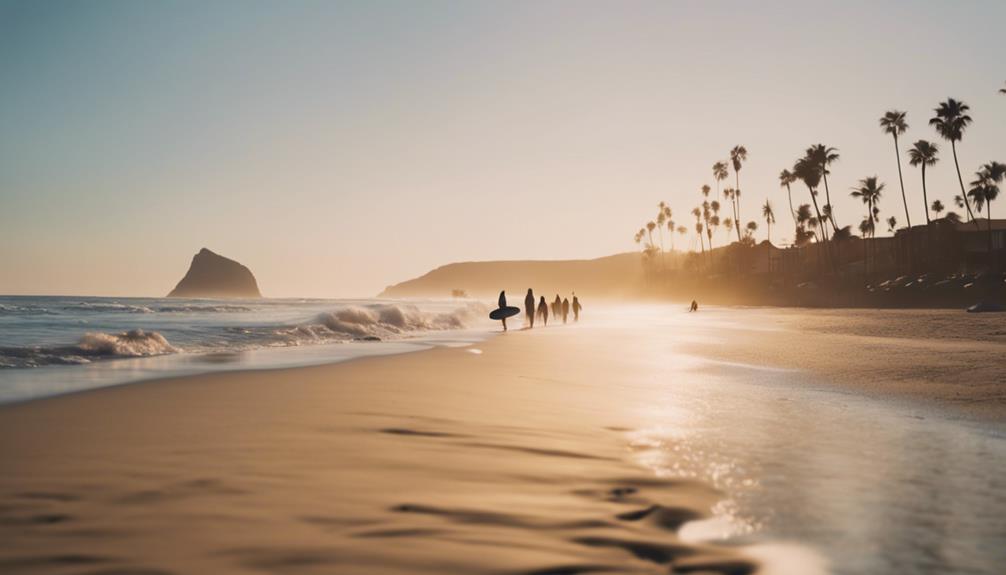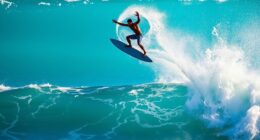If you're looking for the deadliest ride in surfing, the Pipeline in Hawaii takes that title. Known for its powerful tubes and shallow reef, this spot has claimed seven lives since 1989. Each wave presents a fierce challenge, testing even the most skilled surfers. Other notoriously dangerous waves include Teahupoo in Tahiti and Mavericks in California, both known for their massive swells and harsh conditions. Surfers face risks like collisions and wipeouts, making every ride a thrilling gamble. Stick around, and you'll uncover even more about these adrenaline-fueled surfing spots and their history.
Key Takeaways
- Pipeline, Hawaii, is the deadliest surf spot globally, with seven fatalities recorded since 1989.
- Teahupoo, Tahiti, features extreme conditions with heavy waves breaking over a shallow reef, resulting in five deaths since 2000.
- Mavericks, California, presents unpredictable swells and cold waters, leading to notable incidents like Mark Foo's death in 1994.
- Puerto Escondido, Mexico, has three recorded deaths despite enhanced lifeguard services and challenging wave conditions.
Overview of Deadly Waves
When it comes to surfing, certain waves are notorious for their deadly reputation, demanding respect from even the most skilled surfers. One such wave is Pipeline in Hawaii, where seven fatalities since 1989 underline its lethal nature, with powerful waves crashing over a razor-sharp reef.
Teahupoo in Tahiti is another extreme contender, known for its heavy waves and shallow coral, which have claimed five lives and left many more with near-fatal experiences.
In California, Mavericks presents its own threats with cold waters and unpredictable swells, leading to the tragic loss of surfers like Mark Foo and Sion Milosky. Meanwhile, Puerto Escondido in Mexico, despite improved lifeguard services, remains perilous with three recorded deaths, especially during intense wave days.
Waimea Bay, also in Hawaii, has a long history of danger, with incidents stretching back to 1943, where surfers have gone missing amidst the formidable swells.
As a big-wave surfer, understanding the risks associated with these deadly waves isn't just advisable; it's essential for your safety in the water. Respecting these powerful forces can mean the difference between an exhilarating ride and a life-threatening situation.
Iconic Dangerous Surf Spots

When you think about iconic dangerous surf spots, a few names stand out that every surfer should know.
Places like Peahi (Jaws) in Maui and Teahupoo in Tahiti challenge even the most experienced riders with their massive waves and treacherous conditions.
Exploring these locations reveals the excitement and peril that come with chasing the perfect wave.
Peahi (Jaws), Maui
Surfing at Peahi, or Jaws, is an exhilarating yet perilous experience that attracts the bravest wave riders from around the globe. Located on the North Shore of Maui, this spot is notorious for its colossal waves that can soar up to 60 feet during winter swells. Originally ridden by windsurfers in the late 1990s, Peahi has evolved into a mecca for big wave surfing, showcasing extreme skills and breathtaking performances.
The unique geography of Jaws, characterized by steep cliffs and deep water, amplifies the power and speed of the waves, making it one of the deadliest waves on the planet. Surfers face immense challenges not only from the massive waves but also from unpredictable conditions that can lead to severe injuries or even fatalities. Rescue operations are further complicated by the intimidating 300-foot cliff drop, posing significant risks to both surfers and rescue teams.
If you're considering tackling the waves at Peahi, be prepared for an extreme adventure that demands respect, skill, and an awareness of the inherent dangers. This is where surfing reaches its most intense heights—both literally and figuratively.
Teahupoo, Tahiti
Teahupoo, Tahiti, stands out as one of the most iconic and dangerous surf spots in the world, rivaling the notorious waves of Peahi with its unique challenges and extreme conditions. Known as the heaviest wave globally, Teahupoo presents dangers that only the bravest surfers dare to face.
The wave breaks almost below sea level, thanks to a shallow coral reef just 20 inches beneath the surface. Despite swells rarely exceeding 10 feet, the waves pack immense power. Five recorded deaths since 2000 highlight the extreme risks involved in surfing here. Local lore calls it 'The End of the Road,' reflecting both its remote access and the intensity of its waves.
Surfers at Teahupoo must tackle thick lips and hollow-breaking waves, demanding exceptional skill and a deep respect for the ocean's ferocity. Each ride can be exhilarating, but the stakes are high.
If you're considering conquering this legendary wave, prepare yourself both mentally and physically, as the beauty of Teahupoo conceals its perilous nature.
Shipstern Bluff, Tasmania
Shipstern Bluff in Tasmania challenges even the most skilled surfers with its unique wave mechanics and unpredictable conditions. Known as one of the most dangerous surf spots in the world, its waves can soar up to 25 feet, presenting a formidable challenge. The infamous step in the wave formation amplifies intensity, creating powerful swells that can catch you off guard.
Navigating these extreme conditions isn't for the faint-hearted. The deceptive bubbles often mislead surfers, making it essential to stay alert while riding. To add to the thrill, the waters around Shipstern Bluff are frequented by great white sharks, further heightening the risk involved.
Reaching Shipstern Bluff is no easy feat; it requires either a boat ride or a grueling two-hour trek, which limits the number of surfers willing to take on its waves. Those who do, however, find themselves confronting not just the ocean's power but also the raw beauty of Tasmania's rugged coastline.
If you're seeking a true test of skill and nerve, Shipstern Bluff awaits with its dangerous allure.
Profiles of Top Big Wave Surfers

In the world of big wave surfing, Kai Lenny and Lucas Chumbo Chianca stand out as two of the most influential and skilled athletes, each pushing the limits of the sport in their unique ways. Their incredible talent and fearlessness inspire both surfers and fans alike.
Kai Lenny: A multi-talented surfer from the U.S., known for his innovation in big wave surfing and other water sports.
Lucas Chumbo Chianca: A Brazilian sensation celebrated for his performances in extreme conditions, often teaming up with Carlos Burle.
Both athletes have made their mark at the TUDOR Nazaré Big Wave Challenge, showcasing their skills against some of the largest waves in the world. They've notably contributed to the surfing community, inspiring a new generation of surfers.
Kai Lenny continues to push the boundaries with his pioneering techniques, while Lucas Chumbo Chianca impresses with his courage and consistent performances in high-stakes competitions. Together, they embody the spirit of big wave surfing, exemplifying what it means to ride the deadliest waves on the planet.
Unique Wave Mechanics and Risks
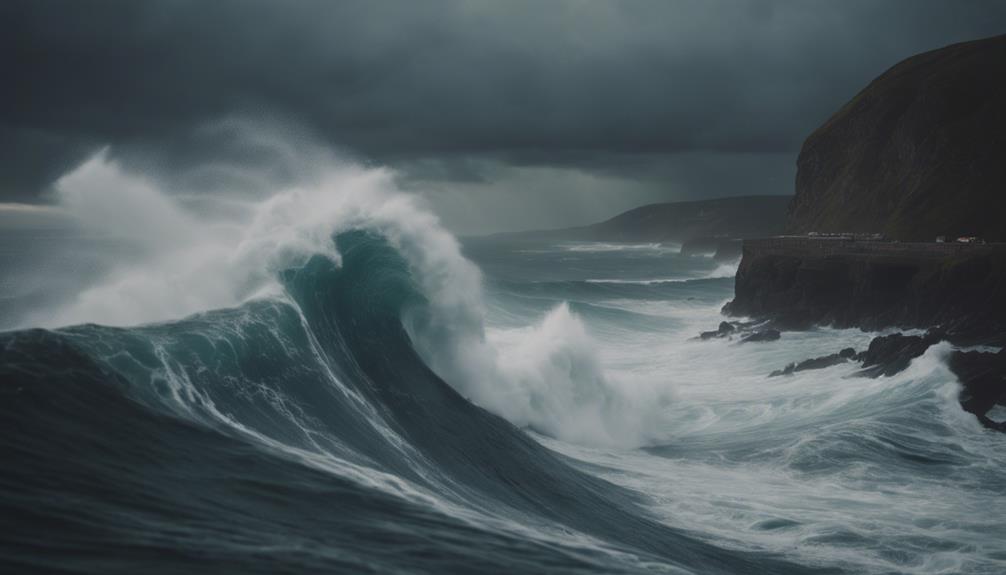
Understanding the unique wave mechanics at various surf spots reveals the intense risks surfers face while maneuvering through these formidable conditions. Each location has its own characteristics that contribute to dangerous wipeouts and life-threatening scenarios.
| Surf Spot | Wave Mechanics | Risks Involved |
|---|---|---|
| Teahupoo | Waves break below sea level on a shallow reef | Severe injuries from powerful waves |
| Mavericks | Fast right-hand waves, some up to 80 feet | Cold water and rocky surroundings |
| Pipeline | Tubular wave formation over a shallow reef | High-impact collisions with the floor |
| Shipstern Bluff | Infamous 'stair steps' amplify wave intensity | Unpredictable breaks and wipeouts |
| Cortes Bank | Deep water with submerged obstacles | Hazardous conditions and massive waves |
At spots like Teahupoo and Pipeline, the shallow reefs create hollow waves that can crash with immense force. Mavericks features towering swells, while Shipstern Bluff's unique stair-step waves increase unpredictability. Cortes Bank remains a wild frontier, where immense waves hide perilous underwater hazards. Each of these locations demands respect and skill to navigate safely.
Historical Records in Big Wave Surfing
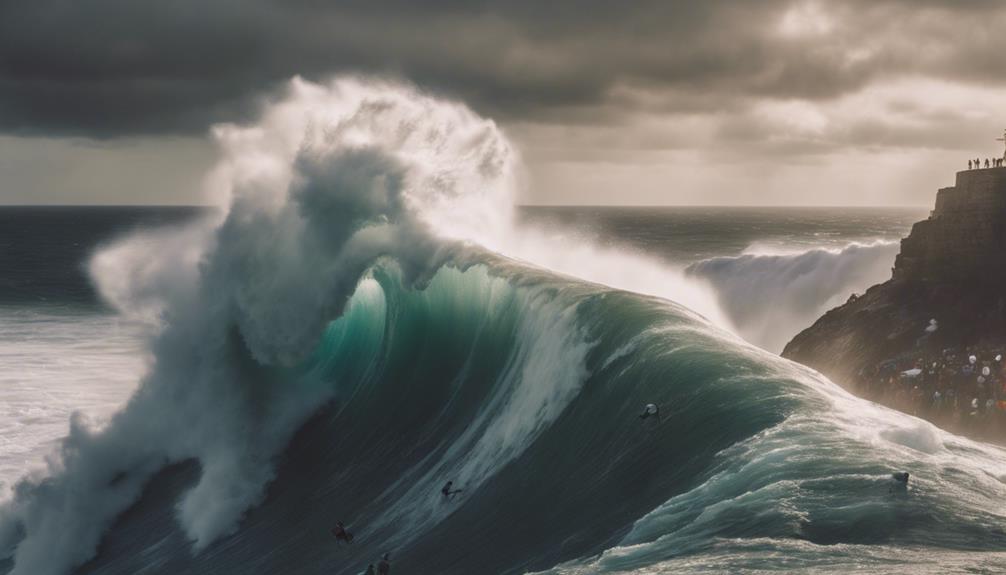
When you think about big wave surfing, you can't ignore the historical records that showcase its most thrilling and dangerous moments.
From record-breaking waves ridden at legendary spots to the evolution of techniques that push the limits, each story adds to the culture of this extreme sport.
Let's explore some of these notable moments that define the legacy of big wave surfing.
Notable Big Wave Moments
Numerous notable moments in big wave surfing history have showcased both the incredible skill of surfers and the extreme dangers they face, making it a thrilling yet perilous sport.
You can't ignore the tragic incidents that highlight the risks involved, especially at notorious locations like:
- Teahupoo, Tahiti: Known for its heavy waves, it has seen five recorded fatalities since 2000.
- Pipeline, Hawaii: The deadliest surf spot globally, with seven fatalities since 1989.
- Mavericks, California: The death of surfer Mark Foo in 1994 drew significant attention to the dangers of big wave surfing.
These moments remind us that while big wave surfing can lead to stunning achievements, it often comes with a heavy price.
The thrill of riding these monstrous waves is accompanied by the sobering reality of the fatalities that have occurred over the years.
Each ride is a demonstration of human courage and skill, but also a reminder of the inherent dangers lurking beneath the surface.
Record-Breaking Waves Surfed
The world of big wave surfing is not just about the risks and tragedies; it's also defined by extraordinary achievements, with surfers consistently breaking records and pushing the limits of what's possible on the water. The deadliest ride of them all, Nazaré, has become a proving ground for elite surfers, where record-breaking waves challenge even the most skilled.
Here's a look at some of the most notable records:
| Year | Surfer | Wave Height |
|---|---|---|
| 2020 | Sebastian Steudtner | 26.2 meters (86 ft) |
| 2023 | Justine Dupont | 75 feet |
| 2011 | Garrett McNamara | 24 meters (78 ft) |
These incredible feats have captured the attention of the surfing community and the Guinness World Records, showcasing the unmatched power and beauty of the ocean. Nazaré continues to attract surfers enthusiastic to conquer the biggest waves, solidifying its place as a landmark in big-wave surfing history and a demonstration of human courage and determination.
Evolution of Surfing Techniques
Surfing techniques have dramatically evolved over the decades, transforming how surfers tackle massive waves and pushing the boundaries of the sport. Today's experienced surfers utilize a variety of innovative approaches to ride heavy water, ensuring both safety and performance.
The shift from longboards to maneuverable shortboards has allowed surfers to execute more intricate maneuvers.
The game-changing rise of tow-in surfing in the late 1990s revolutionized the sport, enabling surfers to access colossal swells at iconic spots like Jaws and Mavericks.
By the 2000s, paddle surfing gained traction, emphasizing strength and skill, with legends like Laird Hamilton showcasing the physical prowess required to ride massive swells without assistance.
Additionally, the introduction of advanced surfboard materials has enhanced performance, empowering surfers to confidently tackle the deadliest waves.
In the surfing world, these advancements have made it possible to conquer previously unreachable Big Waves. Historical records reveal Garrett McNamara's monumental ride of a 78-foot wave at Nazaré in 2011, illustrating the dramatic heights surfing has reached and forever changing the landscape of the sport.
Notable Surfing Competitions
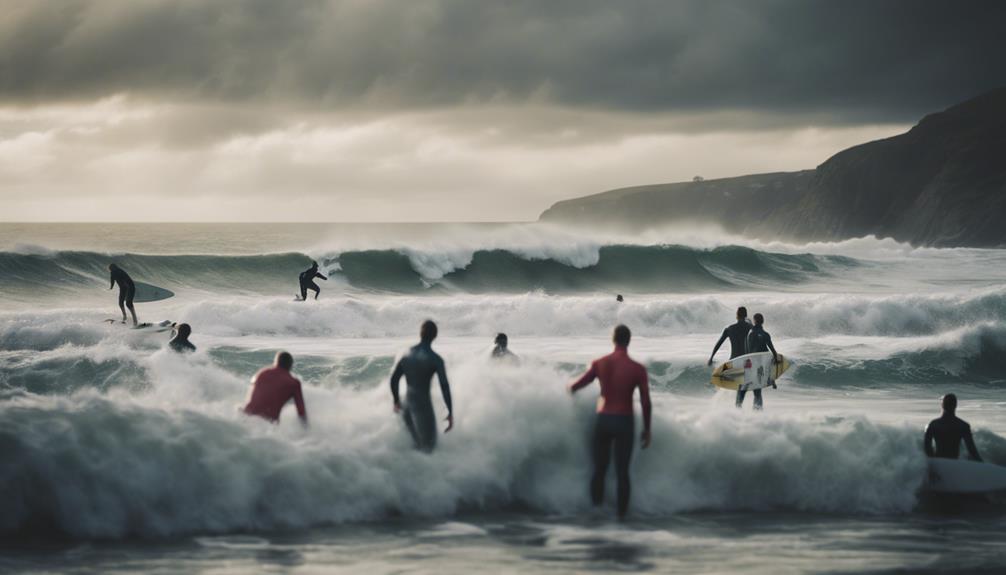
Big wave competitions draw elite surfers from around the world, showcasing their skills against some of the most intimidating waves imaginable.
One of the most anticipated events is the TUDOR Nazaré Big Wave Challenge, set to run from November 1, 2023, to March 1, 2024, in Nazaré, Portugal. Known for its colossal waves, Nazaré is a prime destination for big wave surfing.
Similarly, the TUDOR Jaws Big Wave Challenge at Peahi, Maui, runs from November 1, 2023, to March 31, 2024, where surfers tackle massive waves in extreme conditions.
The WSL Big Wave Surfing Tour features six tour stops, occurring between November 1, 2023, and March 31, 2024, emphasizing the incredible talent and dedication required in this sport.
Additionally, the Big Wave Awards recognize outstanding performances in big wave surfing, including accolades for the largest wave ridden, with records continually being shattered.
Events like the Big Wave World Tour highlight the commitment and skill necessary for competitive big wave surfing, as surfers brave life-threatening challenges in pursuit of glory.
These competitions exemplify the thrilling, yet perilous nature of big wave surfing.
Surfing Culture and Community Impact

Surfers share a unique bond forged by their experiences, steering through both the exhilaration and dangers of riding some of the deadliest waves in the world. This bond is especially strong in places like Teahupoo, where the risks demand a deep respect for the ocean and each other. The surfing culture emphasizes safety protocols, ensuring everyone is aware of the dangers that come with high-stakes waves.
The tragic fatalities at Teahupoo and Pipeline have heightened awareness within the community. High-profile rescues, like Evan Geiselman's at Pipeline, demonstrate the camaraderie among surfers. Legends like Garrett McNamara have transformed local perceptions, boosting pride and tourism. Events like the Big Wave Challenge educate the public on risks while showcasing surfers' dedication.
This sense of camaraderie fosters a supportive environment, where surfers look out for one another. The community impact of surfing transcends just the thrill of the ride; it enriches local economies and strengthens bonds among individuals, creating a culture where respect for the ocean and each other's safety is paramount.
Frequently Asked Questions
What Is the Most Dangerous Wave to Surf?
When you're considering the most dangerous wave to surf, Pipeline in Hawaii often tops the list. Its powerful waves and sharp reefs can create lethal conditions, claiming lives and challenging even the most skilled surfers.
What Surf Break Has Killed the Most People?
When you think about surf breaks that have claimed lives, Pipeline in Hawaii stands out. With seven fatalities since 1989, its powerful waves and shallow reefs create a perilous environment for even the most skilled surfers.
Are the Waves at Nazaré Dangerous?
Yes, the waves at Nazaré are incredibly dangerous. They can reach heights of 100 feet, creating unpredictable and powerful conditions that demand exceptional skill and bravery from surfers who dare to tackle them.
Is Mavericks the Most Dangerous Wave?
Mavericks is often considered one of the most dangerous waves due to its massive heights and unpredictable conditions. If you're a surfer, you should definitely weigh the risks before tackling those powerful swells.
What Makes the Most Dangerous Surfing Wave in the World So Deadly?
The most dangerous surfing wave in the world, known as “The Widowmaker,” is located in Australia. Its deadly reputation comes from the combination of its massive size, powerful currents, and sharp reef break. Surfers brave the risk for the adrenaline rush of conquering the longest surfing wave in endless ride.
Conclusion
As you stand on the shore, watching the colossal waves rise like towering giants, you realize they symbolize both the thrill of adventure and the peril of nature's unpredictability.
Each surf session is a dance with danger, where courage meets respect. The surfing community thrives on this delicate balance, celebrating the legends who dare to ride these treacherous swells.
In embracing the wild spirit of the ocean, you find not just danger but a profound connection to the elements.





